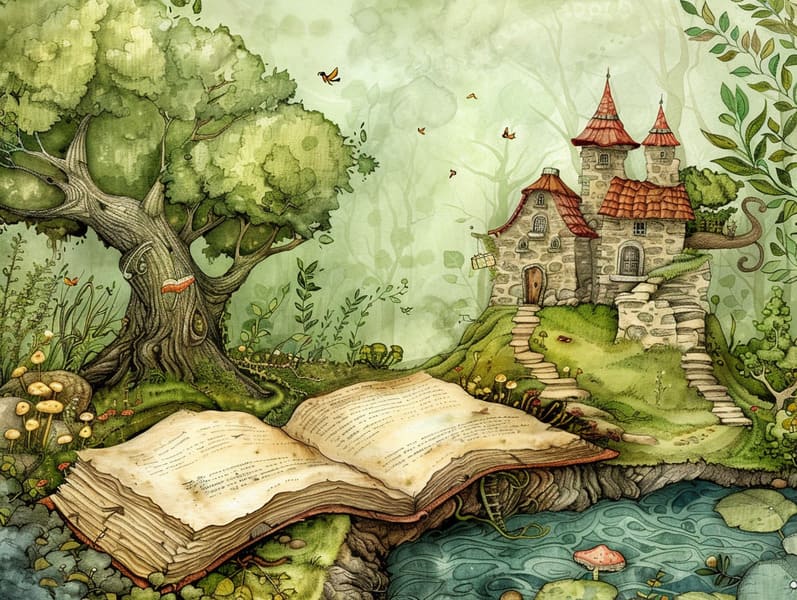Uncovering the Past of Bedtime Fairy Tales with Its Endless Majesty.
Uncovering the Past of Bedtime Fairy Tales with Its Endless Majesty.
Blog Article

Short fairy tales have ancient roots. These stories have been whispered from one generation to the next far before they were ever documented. They emerged from a variety of backgrounds, including Asian traditions. They were initially conveyed among elders, often carrying themes and messages pertaining to the societal norms and beliefs of the time.
The Grimm brothers, Jacob and Wilhelm, were among the first to compile and release many of these beloved fairy tales. Their anthology, "Grimm's Folk Tales," included tales like "The True Bride," "Hansel and Gretel," and "Little Snow White," which have since become pillars in the world of beloved fairy tales. Similarly, Hans Andersen's magical tales, such as "The Story of the Little Mermaid," and "The Story of the Ugly Duckling," have stolen hearts worldwide, securing their place in the pantheon of beloved fairy tales.
Though they are centuries old, classic fairy tales remain as pertinent as ever, especially as kids' bedtime tales. These charming stories are now available in many formats, including gorgeously illustrated books, magical animations, and digital storybooks.
Their enduring popularity can be attributed to several magical reasons:
Valuable Lessons: Timeless fairy tales often illustrate important moral lessons. Fairy tales like "The Tale of the Boy Who Cried Wolf" teach the significance of integrity, while "The Tale of the Tortoise and the Hare" emphasize the values of determination and unpretentiousness. These stories offer little ones clear distinctions between correct and incorrect, shaping their moral compass in a mild yet lasting way.
Compassion and Insight: Old fairy tales frequently present personalities facing challenges and struggles, stimulating audiences to identify with their struggles and encourage their triumphs. For instance, "Beauty and Her Beast" illustrates the necessity of seeing beyond looks to perceive the true being of a character, nurturing empathy and perception.
Cultural Recognition: Many classic fairy tales are rooted in the cultural contexts from which they arose. Exploring these fairy tales can provide intriguing perspectives into different beliefs, building a sense of world understanding and perception.
Inventiveness and Imagination: The imaginative elements in fairy tales—enchanted forests—invigorate children’s dreams. These narratives lead readers to magical realms, engendering inventive ideas and a sense of curiosity that remains a lifetime.
Classic fairy tales are not only charming but also instructive. They serve as charming tools in strengthening various cognitive and emotional skills in the young. When ancient fairy tales are told out loud, they cultivate language acquisition by showing new linguistic elements and sophisticated sentence structures. This practice also improves listening abilities and attention span, as children keep up with the story, ready to see what happens next.
Furthermore, discussing the themes and characters of fairy tales can improve problem-solving abilities and critical thinking. Children are shown to identify patterns, predict happenings, and comprehend cause and effect. These talks also advance young ones speak out their thoughts and feelings, adding to their emotional intelligence.
In today’s online age, the presence of digital storybooks has made these fairy tales more reachable than ever. Web platforms and programs make available broad selections of ancient fairy tales that can be viewed or listened through anytime, anywhere. Fairy tales recited are particularly widespread, supplying an interactive method for young ones to be a part of these bewitching tales. Read-aloud books and read-out-loud stories guide characters and settings to life, often complemented by delightful audio effects and soundtracks that enrich the tale experience.
The lasting allure of ancient fairy tales lies in their ability to adapt to modern times while maintaining their central values. Contemporary retellings of these narratives often present more diverse protagonists and modern settings, making them familiar to today’s audience. However, the central morals of valor, charity, and impartiality remain unchanged, continuing to appeal to young readers of all ages.
Classic fairy tales also offer a sense of coziness and predictability. They serve a well-ordered narrative with a plain beginning, middle, and end, often winding up with the click here wrap-up of conflicts and the triumph of morality over wickedness. This constancy can be placating for young ones, presenting a sense of steadfastness in an fluctuating world.
Traditional fairy tales continue to spellbind and train new generations, maintaining their magic and relevance in modern society. As children's night stories, they extend a perfect blend of allure and teaching, advancing moral values, empathy, and creativity. The accessibility of internet fairy tales and the widespread nature of fairy tales spoken certify that these classic narratives remain obtainable to new generations.
By guarding and relating these narratives, we continue to laud the rich tapestry of mythology and cultural heritage. Whether you are discovering a artistically illustrated book, delving into a digital library, or listening on an read-aloud book, the captivation of Grimm's fairy tales is always within reach. These fairy tales emphasize of the unwavering power of storytelling and its ability to unite us across eras and regions.
Regardless if you are browsing a colorful picture book, viewing a cyber collection, or listening on an audiobook, the enchantment of children's fairy tales is always within reach.
These narratives remind us of the enduring force of stories and its ability to draw us together across epochs and places, weaving a spell that captivates and teaches alike.